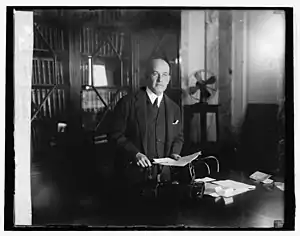Julian Codman
Julian Codman (September 21, 1870 – December 30, 1932),[1] was an American lawyer who was a vigorous opponent of Prohibition who was also involved with the Anti-Imperialist League.[2]

Early life
Codman was born in Cotuit, Massachusetts, on September 21, 1870. He was the son of Col. Charles Russell Codman (1829–1918), a colonel in the Union Army who commanded the 45th Massachusetts Volunteer Infantry, and Lucy Lyman Paine (née Sturgis) Codman (1833–1907).[3] Among his siblings were Russell Sturgis Codman; John Sturgis Codman; Anne McMasters Codman, who married Henry Bromfield Cabot; and Susan Welles Codman, who married Redington Fiske.[1]
His maternal grandfather was Russell Sturgis, a wealthy Boston merchant active in the China trade,[4] and his uncle was noted architect and builder John Hubbard Sturgis,[3] who designed the Codman House in Lincoln, Massachusetts and the Boston Museum of Fine Arts, along with Charles Brigham.[5]
Codman received an AB from Harvard University in 1892 and an LLB degree from Harvard Law School in 1895. He passed the Massachusetts Bar exam in 1895 and began practicing as a lawyer.[1][6]
Career
Codman, an Independent, was a member of the Executive Committee of New England Anti-Imperialist League from 1902–04. In 1904, he was a Delegate of Democratic National Convention, a Signatory of Philippine Independence Committee Petition, and he sat on the Executive Committee of Anti-Imperialist League. In 1918, he was the vice-president of Anti-Imperialist League.[1]
From 1916 until 1919, Codman served in the U.S. Army during World War I, achieving the rank of Colonel.[1]
He was also a vice-president of the Associated Charities, headed the Constitutional Liberty League and served as counsel for the Joint Legislative Committee, was a foe of prohibition. He twice represented the combined anti-Prohibition societies at Congressional hearings.[1]
Codman co-wrote Secretary Root's Record:"Marked Severities" in Philippine Warfare.[1]
Personal life
In 1897, he married Norah Chadwick (1873–1961), daughter of James Read Chadwick and his wife Katherine Maria Lyman. They had two daughters, who were the wives of Guy Morris and Ransom F. Hodges.[1]
Codman died at the Massachusetts General Hospital in Boston on December 30, 1932, and was buried at Forest Hills Cemetery, which is located in the Forest Hills section of the Jamaica Plain neighborhood of Boston, Massachusetts.[1]
References
- "J. CODMAN IS DEAD; LONG DRY LAW FOE; Boston Attorney Was Widely Known as a Vigorous Prohibition Opponent. COUNSEL FOR WET GROUPS Began Fight Soon After Passage of Volatead Act--Was Executive Commander of Crusaders" (PDF). The New York Times. December 31, 1932. Retrieved 11 September 2018.
- "Codman Urges Virulent to Disregard Dry Law". Harvard Crimson. 11 May 1926.
- Alstyne, Lawrence Van; Ogden, Charles Burr (1907). The Ogden family in America, Elizabethtown branch, and their English ancestry: John Ogden, the Pilgrim, and his descendants, 1640–1906. Printed for private circulation by J.B. Lippincott company. p. 407. Retrieved 11 September 2018.
- Napier, Priscilla (1995). Barbarian Eye. Brassey's. p.207
- Wiencek, Henry; Lucey, Donna M. (1999). National Geographic Guide to America's Great Houses: More Than 150 Outstanding Mansions Open to the Public. National Geographic Society. p. 34. ISBN 9780792274247. Retrieved 11 September 2018.
- Brandeis, Louis D. (1973). Letters of Louis D. Brandeis: Volume III, 1913–1915: Progressive and Zionist. SUNY Press. p. 301. ISBN 9781438422596. Retrieved 11 September 2018.